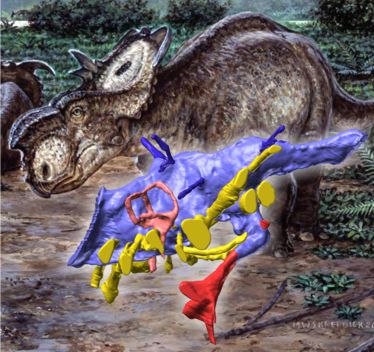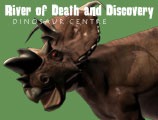- News & information
- About
- History
- George V. Voinovich
- George V. Voinovich Collection
- Calendar
- How to Find Us
- News
- Archives
- Photojournalism Fellowship Project
- Photo Essays
- Current Fellow
- Previous Fellows
- Reports and Publications
- Archives
- Students
- Prospective
- Center for Entrepreneurship
- Environmental Studies
- HTC/Voinovich School Scholars
- Master of Public Administration
- Current
- HTC/Voinovich School Scholars
- Center for Entrepreneurship
- Environmental Studies
- Master of Public Administration
- Alumni
- Contact
- School Leadership
- Strategic Partners Alliance
- Ohio University Public Affairs Advisory Committee
- Ohio University Public Affairs Advisory Committee
- Faculty and Fellows
- Faculty
- Visiting Professors
- Voinovich Fellows
- Professional Staff
| Lawrence M. Witmer,
PhD
|
 |
The brain and ear of Pachyrhinosaurus, a Cretaceous horned dinosaur from Canada |
Common Language Summary

Paradox revealed? The
simple brain of a seemingly complex dinosaur.
Horned dinosaurs (ceratopsians) give the appearance of having
had sophisticated social interactions, with heads adorned with
sometimes elaborate horns, frills, and other display structures.
But did they have the brain power needed for sophisticated
behaviors? The Pipestone Creek bone bed of west-central Alberta
provides a unique glimpse into the biology of a new ceratopsian
species. Pachyrhinosaurus lakustai
is represented by
hundreds of bones from individuals of diverse ages that perished
more or less together and were transported to their final
resting place, later to be entombed in 73-million-year-old Upper
Cretaceous rocks. The isolated bony braincase of a subadult
individual was CT scanned and analyzed using advanced computer
3D-visualization software. The resulting “virtual brain” in some
ways doesn’t look much like a brain, because the brain itself
was too small to impress its form into the bony walls that
surrounded it. Indeed, the most remarkable aspect of the brain
structure of Pachyrhinosaurus
is how small and primitive
it must have been. There is no evidence for any marked expansion
of the neural centers of smell (olfactory bulbs), vision (optic
lobes), motor coordination (cerebellum), or higher cognitive
function (cerebrum). Likewise, the relatively short cochlea of
the inner ear suggests that hearing air-borne sounds was not
especially important for Pachyrhinosaurus
. The small,
primitive cerebral hemispheres are particularly interesting,
because in modern animals these are the seat of higher
behavioral functions such as learning and problem-solving. They
are so small in Pachyrhinosaurus
that it is tempting to
question how sophisticated its behavioral repertoire could have
been. Despite the cranial ornaments suggestive of perhaps
elaborate behavioral displays and other evidence suggesting
herding behavior or even migration, the behaviors of Pachyrhinosaurus
were probably relatively simple,
stereotyped, and instinctual.
| A technical article
was published on 1 October 2008 in a National Research Council of Canada Monograph
• Download a PDF of the published article (posted with NRC permission): • Download a PDF of high-resolution versions of the figures • Download a "Super-PDF" comprised of the article, hi-res figures, and a low-res version of the 3D PDF (16.7 MB) |
3D VIZ DOWNLOADS |
| This website provides supplementary information as an
adjunct to the published paper. Witmer, with the skilled
assistance of Ryan Ridgely
, is responsible for
the content of the website. Content provided here is for
educational and research purposes only, and may not be used for
any commercial purpose without the permission of L. M. Witmer
and other
relevant parties.
This project was funded by grants from the National Science Foundation . |
Contact Information:
(740) 593–9381 | Building 21, The Ridges
Ohio University Contact Information:
Ohio University | Athens OH 45701 | 740.593.1000 ADA Compliance | © 2018 Ohio University . All rights reserved.




















